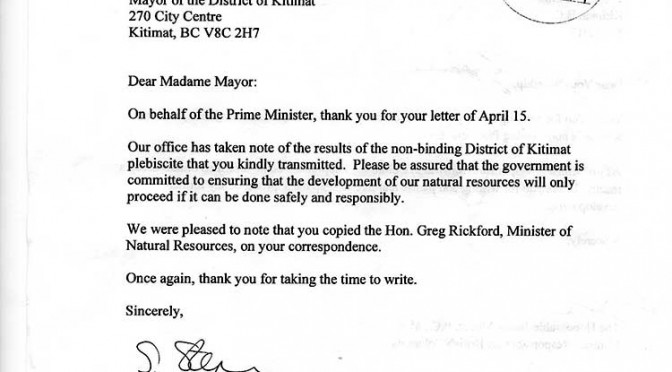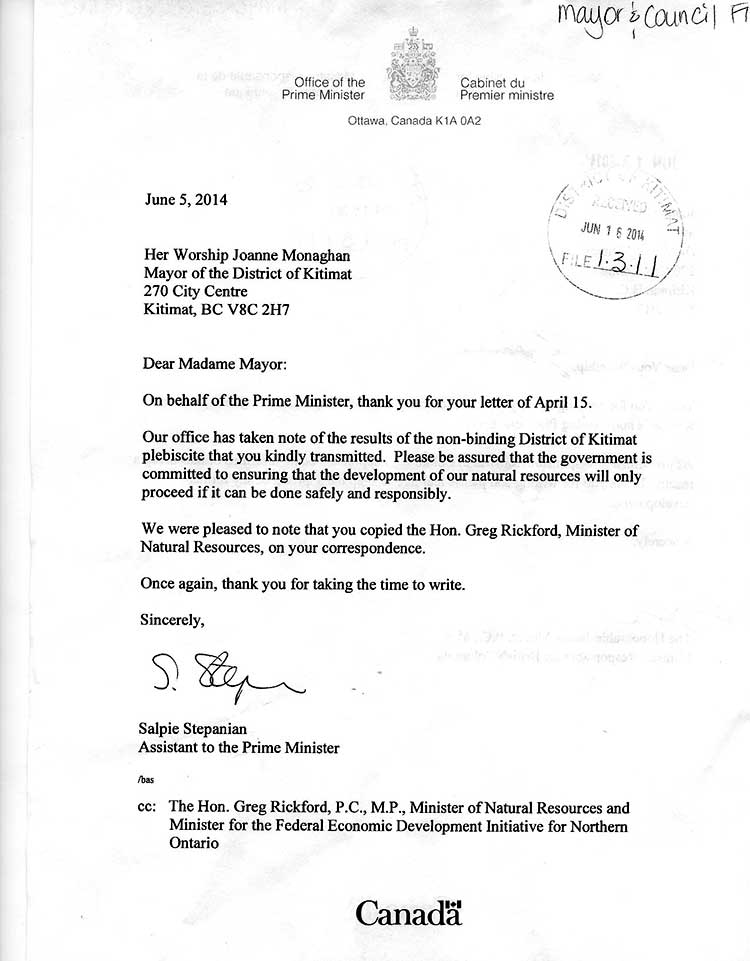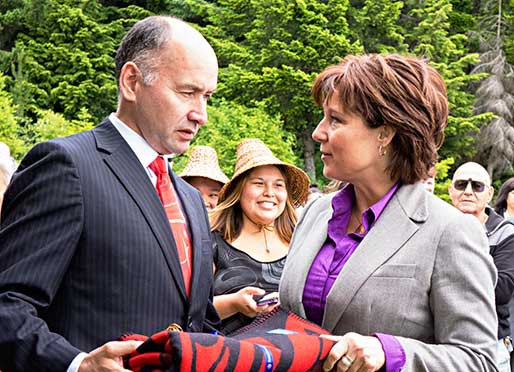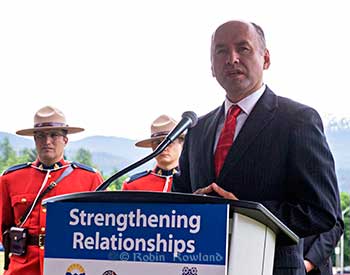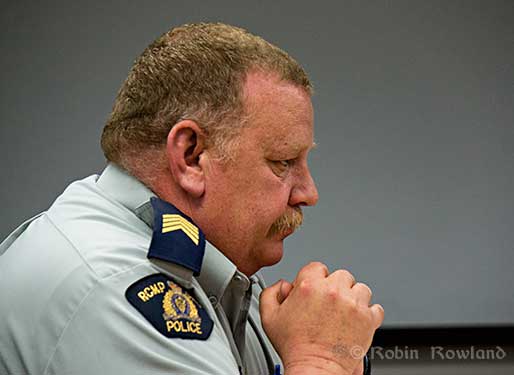The response to the Joint Review Panel decision on the Northern Gateway, beginning in December and continuing until this Canada Day, both in the public and in the media is sharply divided by the Rocky Mountains.
A lof of Albertans, most of the energy companies and many in the media, especially the Toronto-based business press, keep telling Canadians that the NEB is an independent, quasi-judicial body, that carefully weighs the scientific and other evidence before coming to a conclusion.
Prime Minister Stephen Harper stands up in Question Period and from his prepared script also claims the JRP and NEB are independent bodies.
Most of those writing about the attitude of the National Energy Board have never attended a single hearing, As for the Joint Review,. those from the major media who did attend were only there for the opening and closing sessions.

In British Columbia, those attended the Northern Gateway Joint Review sessions saw a strange and arcane bureaucratic system with rules of evidence and procedure often tilted toward a proponent in the energy sector.
Those rules of evidence were created for the cosy club atmosphere of the NEB in Calgary where mostly there are friendly hearings attended only by the proponents and energy sector lawyers. Those same rules were infuriating to those in northwest British Columbia trying and failing to persuade the JRP to take seriously many of the concerns of the region. The rules of evidence and procedure were baffling to lawyers practicing in BC; even the highly experienced lawyers from the BC Department of Justice were chewed out by the JRP in Prince George for not following proper procedures.
Most egregious was the JRP’s refusal to consider the late evidence on the growing number of humpback whales in Douglas Channel.

The JRP seemed to believe that time stopped at the evidentiary deadline, and although it acknowledged that Northern Gateway was a 50 year project, the panel didn’t need to know anything new.
A careful reading of the two volumes of the Joint Review Panel report and decision clearly shows that JRP finding was not, as one columnist called it, a triumph of science over emotion, but a proceeding that was biased from the outset to find in favour of Enbridge. It is clear that even though the Joint Review Panel did impose 209 conditions on Northern Gateway, reading those almost 500 pages one sees time and time again that Northern Gateway’s evidence and assurances were accepted at face value, while the panel treated the evidence and testimony from opponents with a much higher level of skepticism.
Moving to Calgary
One of my sources once told me that the “NEB is nothing more than an extension of the Petroleum Club.” In the 1991 budget, then Prime Minister Brian Mulroney moved the NEB headquarters from Ottawa to Calgary as a political gift to Alberta.
At that time the move was also seen as practical, Alberta was still complaining no one in Ottawa was listening to it. So if the Conservative government moved the NEB to Calgary, it would be there listening to the oil patch. NEB offices were scattered across the country, consolidating them in Calgary seemed, at the time, to be a way of saving taxpayers’ money and enhancing internal communications.
Seen now, about 25 years later, it’s clear the NEB move from its Ottawa headquarters and regional offices to Calgary was a disaster waiting to happen. Over the past quarter century, despite its claims of independence, the NEB and its staff have become so embedded in the oil patch energy culture of Calgary that (probably subconsciously) the NEB has shown that it is largely incapable of really taking seriously the culture of British Columbia on issues such as the Northern Gateway and Kinder Morgan projects. The NEB Calgary culture is also colliding,with the concerns and culture of other parts of the country as diluted bitumen pipelines head eastward.
That embedding in Alberta isn’t going to change. It might have been a good idea to move the NEB headquarters back to Ottawa but it’s too late for that. The NEB this week is moving to new quarters in Calgary at a cost to taxpayers of a staggering $21 million.
The Conservative omnibus bills that gutted environmental protection and speed up the review process has made things much worse–at least until this week.
Now the Supreme Court has sent a shot across the bow of the full steam ahead National Energy Board, compelling the board to put much more weight on the concerns of First Nations.
The decision upholding the Tsilhqot’in claim to its traditional territory means the NEB and any future joint review panel (whether involving multiple federal agencies or federal agencies and a province) are going to have to take the concerns of First Nations and indeed all Canadians a lot more seriously—and the future of the planet as well, as described in the first part of this analysis. Chief Justice Beverly McLaughlin wrote that on First Nations` traditional territory:
that it is collective title held not only for the present generation but for all succeeding generations. This means it cannot be alienated except to the Crown or encumbered in ways that would prevent future generations of the group from using and enjoying it.
“Future generations” is the key phrase.
Future generations could undermine that whole world view of the Joint Review Panel, since the panel so casually dismissed the fears of a major disaster on the coast, saying it was “unlikely” and could be “mitigated.”
The JRP basically had a so-what attitude to British Columbia, arguing that since parts of the British Columbia environment had already been degraded any future environmental problems would be minimal and could be “mitigated.”
Public interest
While in the introduction to its definition of the Public Interest, the JRP says
If approved and built, the Enbridge Northern Gateway Project could operate for 50 years or more. Sustainable development was an important factor in our environmental assessment and our consideration of the public interest. The project would have to meet today’s needs without compromising the ability of future generations.
Sounds like that might match the Chief Justice. But, as the old saying goes, the devil is in the details. And just a few paragraphs later, the JRP says:
Our assessment of the project’s effects on residents and communities Considering Northern Gateway’s project design, its commitments, and our conditions, we concluded that the project’s potential effects on people’s land, water, and resource use could be mitigated. We were not persuaded that construction and routine operations of the project would have a negative effect on the social fabric of communities in the project area. We also were not persuaded that the project would adversely affect the health and well being of people and communities along the route or in coastal areas. We found that the net overall economic effects of the project would be positive and would provide potential benefits and opportunities to those individuals and businesses that choose to participate in the project.
“Trust Enbridge”
The JRP’s attitude toward a major disaster was “trust Enbridge.”
We found that some level of risk is inherent in the Enbridge Northern Gateway project, and that no party could guarantee that a large spill would not occur. We found that a large spill, due to a malfunction or accident, from the pipeline facilities, terminal, or tankers, is not likely.
We found that Northern Gateway has taken steps to minimize the likelihood of a large spill through its precautionary design approach and its commitments to use innovative and redundant safety systems, such as its commitments to address human error, equipment failures, and its corporate safety culture. These commitments and all others made by the company
Oh well, the ecosystem will recover eventually—a conclusion that could be reached only by ignoring the evidence from Prince William Sound, site of the Exxon Valdez spill.
We found that, in the unlikely event of a large oil spill, there will be significant adverse environmental effects, and that functioning ecosystems recover through mitigation and natural processes.
We found that a large oil spill would not cause permanent, widespread damage to the environment. The extent of the significant adverse effects would depend on the circumstances associated with the spill. Scientific research from past spill events indicates that the environment recovers to a state that supports functioning ecosystems similar to those existing before the spill. We found that, in the unlikely event of a large oil spill, there would be significant adverse effects on lands, waters, or resources used by residents, communities, and Aboriginal groups.
We found that, in rare circumstances, a localized population or species could potentially be permanently affected by an oil spill. Scientific research from a past spill event indicates that this will not impact the recovery of functioning ecosystems.
In other words, some communities, probably aboriginal communities, would have be sacrificed in the public interest and the economics of Alberta while the economy of that part of British Columbia would be destroyed.
Will the JRP have to start over?
The environmental law community and First Nations leaders are already taking a look at another paragraph in the Supreme Court judgement. Paragraph 92 in lawyer speak.
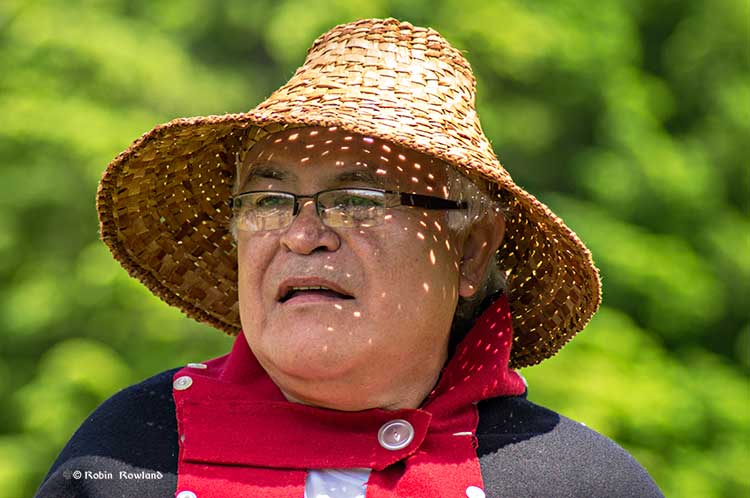
One of the many reports comes from West Coast Environmental Law which noted in an e-mail
[T]he Tsilhqot’in decision, Canada’s highest court brings home the implications of this for Enbridge and other project proponents:
Once title is established, it may be necessary for the Crown to reassess prior conduct in light of the new reality in order to faithfully discharge its fiduciary duty to the title-holding group going forward.
For example, if the Crown begins a project without consent prior to Aboriginal title being established, it may be required to cancel the project upon establishment of the title if continuation of the project would be unjustifiably infringing.
And what about the overhaul of environmental legislation in 2012 to smooth the way for pipeline and other industrial development?
The court notes: “Similarly, if legislation was validly enacted before title was established, such legislation may be rendered inapplicable going forward to the extent that it unjustifiably infringes Aboriginal title.”
Reset
In other words, the Supreme Court decision resets everything.
It could nullify the recent decision by the Prime Minister to permit the Northern Gateway to go ahead. Or it could mean, especially given the number of court challenges just to the JRP, that, in light of the Tsilhqot’in decision the panel will be ordered by a court to go back to the drawing board and reconsider its findings.
Then there are the pending challenges to the Harper decision allowing the Northern Gateway to go ahead. Sources told Northwest Coast Energy News that the first of a number of court challenges were to be filed last week. It is likely that after the holiday weekend, lawyers will be rewriting their filings and their briefs in light of the Tsilhqot’in decision and presenting the Federal Court with those challenges some time in July.
The justices of the Supreme Court did allow a public interest exemption on the use of First Nations land for a larger purpose, but there must now be genuine consultation and the public interest will likely have be proven beyond a reasonable doubt, it can’t just be the whim of a prime minister with a tame, unquestioning caucus who decides what is in the public interest.
Who consults whom?
In the decision, Chief Justice McLaughlin wrote:
Governments and individuals proposing to use or exploit land, whether before or after a declaration of Aboriginal title, can avoid a charge of infringement or failure to adequately consult by obtaining the consent of the interested Aboriginal group
and later
The right to control the land conferred by Aboriginal title means that governments and others seeking to use the land must obtain the consent of the Aboriginal title holders. If the Aboriginal group does not consent to the use, the government’s only recourse is to establish that the proposed incursion on the land is justified under s. 35 of the Constitution Act, 1982.
Compare that again with what the JRP said. As with the environmental impact it begins by saying:
The Panel finds that the magnitude, extent, and potential impacts of this project required an extensive program of public consultation. The Panel considers thorough and effective consultation to be a process that is inclusive of, and responsive to, all potentially-affected groups and individuals.
Then the JRP says:
The Panel notes that, among potentially-affected parties, there were differing perspectives on what constitutes a thorough and effective process of consultation. There were also different views among some parties about how consultation should occur, and their roles and responsibilities during consultation.
And then:
The Panel believes that it is critical for all parties to recognize and understand their respective roles and responsibilities for achieving effective dialogue during consultation. The Panel noted the principles of thorough and effective consultation at the beginning of this chapter. The Panel finds that these principles require that a process must provide timely, appropriate, and effective opportunities for all potentially-affected parties to learn about a project, provide their comments and concerns, and to discuss how these can be addressed by the applicant.
So what does it mean?
The JRP starts off by giving Northern Gateway a slap on the wrist:
The applicant [Enbridge] must be genuinely responsive. Affected parties have an ongoing and mutual responsibility to respond to opportunities for consultation, to communicate concerns they may have, and to discuss how these can be addressed.
But then it goes on in the same paragraph:
Consultation requires trust, mutual respect, and relationship-building. All parties have an obligation to seek a level of cultural fluency, in order to better understand the values, customs, needs, and preferences of the other parties involved in the consultation process. All parties may be required to adjust their expectations in response to the information, concerns, and interests raised and considered through the process. The Panel observed that this approach did not always occur in this proceeding.
Get the phrase “all parties.” It is clear here that the JRP is taking on the First Nations and other opponents for not seeing Northern Gateway’s point of view, since it accepts, as seen below, Northern Gateway’s contention that it is doing a good job with consultation,
And the word “trust.” Again the Alberta-bound JRP (the panel had no members from British Columbia, two from Alberta, one from Ontario) are saying “trust Enbridge.”
Unfortunately after a decade of operating in the northwest, and despite its spin, Enbridge has failed time and time again to establish trust with First Nations and it has equally failed to establish trust with a significant number non-aboriginal residents of the northwest.
The companies developing LNG projects have, for the most part, established a level of trust.
The joke up here is now so old it’s a cliche (but still unknown to the eastern media) where an LNG executive says, “We look at what Enbridge did and do the exact opposite.”
The Panel accepts Northern Gateway’s view that consultation is a process which should ensure that all parties are better informed through consultation, and that it involves being prepared to amend proposals in light of information received. In this regard, the Panel notes that Northern Gateway made numerous changes to the design and operation of the project in response to input provided by the public, landowners, governments, and stakeholders
In fact, Northern Gateway is still fumbling the ball.
It is true that Northern Gateway did change its plans and put another $500 million into the plans for the project–after a lot of public pressure and growing controversy during the JRP hearings over its plans.

Equally telling was Northern Gateway’s dismissal in its final arguments (arguments accepted by the JRP) that there was no earthquake hazard in the region, despite two major earthquakes at Haida Gwaii and southern Alaska just months earlier, both of which shook Kitimat.
In the final oral arguments, Northern Gateway’s lawyer Richard Neufeld summarily dismissed the fears of the Haida and Heiltskuk First Nations about destruction of the herring spawning beds because, he said, first, the chances of a tanker disaster were unlikely and second, even if there was a tanker disaster it was even more unlikely that it would occur during the spawning season. (Not that the spawning season matters, herring beds in San Francisco Bay are still damaged years after a spill there).
Now with the Tsilhqot’in decision, Enbridge can no longer summarily dismiss those fears. The companies who have proposed liquefied natural gas projects are meeting with anyone, including avowed opponents, and opening dialogues, even if both sides continue to disagree. Despite its spin, accepted by the political pundits and eastern business media, those who live in the northwest know Northern Gateway’s consultations and engagement, so far, have mostly been with friendly groups and friendly audiences.
The Supreme Court decision is going to change that attitude in the coming weeks. If Enbridge wants Northern Gateway to go ahead, the company is going to have to genuinely engage with First Nations. Given all the damage created by Enbridge over the past decade, that engagement is unlikely to change anything.
The Supreme Court decision is going to have one more consequence.
Eventually, in a few years, the decision will negate that stupid attitude from the conservative media and some in the business community that the people of northwestern British Columbia are against all development. That was never true but it’s a convenient excuse for those columnists and conservatives not to question their own assumptions.
If the reporters and columnists had bothered to come up here, if the press-release dispatching business leaders had bothered to leave their executive suites, they’d know what northwestern BC wants is responsible and sustainable development, not quick in and out profits.
The Supreme Court decision means that any future industrial development in the northwest will be much different from anything seen in the past because First Nations must be involved from the beginning.
Given its sorry track record, it is unlikely that Enbridge will be part of that development. but others will profit, yes profit, from that failure.
In the coming years it is also likely that there will be a new approach to development from the National Energy Board after they begin to see their narrow oil-patch friendly approach and rulings struck down by the courts quoting the Tsilhqot’in decision.

